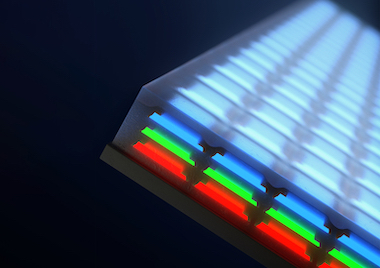Vertical multicolored micro-LED allows smaller pixels and higher pixel density.

Upright position: vertical pixels
A project at MIT has developed a possible new route to sharper defect-free displays, by stacking the light emitting diodes into vertical multicolored pixels.
Although the size of conventional LED pixels has been consistently reduced over recent years, they are reaching a point where the small size can affect their performance, according to MIT.
This is particularly true for displays designed to sit close to the viewer's eyes, such as those in augmented and virtual reality devices, where limited pixel density adversely influences the perceived quality of the image.
The MIT project has invented a method of stacking the red, green, and blue light-emitting diodes into vertical pixels, rather than having them side by side in a horizontal grid. Each stacked pixel can then generate the full commercial range of colors, according to the project team.
"This is the smallest micro-LED pixel, and the highest pixel density, reported in the journals," said MIT's Jeehwan Kim. "We show that vertical pixelation is the way to go for higher-resolution displays in a smaller footprint."
As described in Nature, the vertically stacked pixels could be particularly valuable for the creation of visual experiences immersive enough that MIT believes a user "wouldn’t be able to distinguish virtual from reality."
"In conventional displays, each R, G, and B pixel is arranged laterally, which limits how small you can create each pixel," said Jiho Shin from MIT. "Because we are stacking all three pixels vertically, in theory we could reduce the pixel area by a third."
The project's manufacturing technique builds on previous MIT research into ways to grow and peel away perfect, two-dimensional, single-crystalline material from wafers of silicon and other surfaces, an approach termed 2D material-based layer transfer (2DLT).
Researchers used the same approach to grow ultrathin membranes of red, green, and blue LEDs. They then peeled the entire LED membranes away from their base wafers, and stacked them together to make a layer cake of red, green, and blue membranes. This was then carved into patterns of tiny, vertical pixels, each as small as 4 microns wide.
Ultimate solution for small displays
"Recent demonstrations of vertical micro-LED displays have attempted to address pixel density by stacking freestanding RGB LED membranes and fabricating top-down, but minimization of the lateral dimensions of stacked micro-LEDs has been difficult," noted the team in its published paper.
"We report full-colour, vertically stacked micro-LEDs that achieve, to our knowledge, the highest array density (5,100 pixels per inch) and the smallest size (4 microns) reported to date."
In trials the project fabricated vertical LED pixels, and showed that by altering the voltage applied to each of the red, green, and blue membranes, one pixel could produce various colors. A higher current to red and weaker current to blue produces a pink output color, for example. MIT said that its technique can cover almost the complete commercial color space in this fashion.
Having shown that a full spectrum is possible, the project now intends to work towards an array of several vertical micro-LED pixels. A fully operational system might need to control 25 million LEDs separately, according to MIT, so the active matrix operation will require further development.
"For now, we have shown that we can grow, peel, and stack ultrathin LEDs," commented Jeehwan Kim. "This is the ultimate solution for small displays like smart watches and virtual reality devices, where you would want highly densified pixels to make lively, vivid images."
TrendForce 2022 Micro LED Self-Emissive Display Trends and Analysis on Supplier's Strategies
Release date: 31 May 2022 / 30 November 2022
Format: PDF
Languages: Tradional Chinese / English
Pages : 130–150 in total (subject to change)
If you would like to know more details , please contact:












